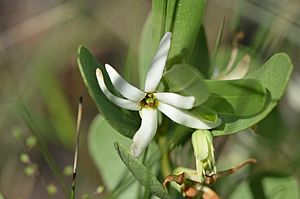Beautiful pawpaw facts for kids
Quick facts for kids Beautiful pawpaw |
|
|---|---|
 |
|
| Conservation status | |
| Scientific classification | |
| Genus: |
Asimina
|
| Species: |
pulchella
|
The Asimina pulchella, also called the beautiful pawpaw, royal false pawpaw, or white squirrel banana, is a very rare flowering plant. It belongs to the custard apple family. This plant is so rare that the government has listed it as an endangered species. This means it is in danger of disappearing forever.
Where It Lives
This special plant grows only in Florida, in the United States. When a plant or animal lives only in one place, it is called endemic. There are only about 5,000 of these plants left. They live in small, separate areas of their natural home, which is called fragmented habitat. These areas are found in three counties in Florida.
The beautiful pawpaw grows in slash pine woods. It likes sandy soil. Other plants that grow near it include saw palmetto, fetterbush, shiny blueberry, dwarf live oak, and tarflower. You can find this plant in Charlotte, Lee, and Orange Counties. The plants in Orange County are about 100 miles away from the others. This is called a disjunct population.
What It Looks Like
This plant is a small shrub. It usually grows less than half a meter (about 1.5 feet) tall. It has a long main root called a taproot. Its leaves are tough and leathery. They are shaped like an oval or a spoon. The leaves are usually 4 to 7 centimeters (about 1.5 to 2.7 inches) long.
The plant has a single flower that hangs down or stands up. It grows on a short stem called a peduncle. These flowers smell very sweet! They have white or pinkish petals that are 2 or 3 centimeters (about 0.8 to 1.2 inches) long. The sweet smell comes from special chemicals, like veratrole and linalool.
Tiny insects help the flowers make seeds. These insects include the beetle Mordella atrata and tiny thrips like Frankliniella bispinosa and Thrips hawaiiensis. The plant's pollen is shed in groups of four.
After the flower is pollinated, it grows into a large, yellow-green berry. This fruit can be up to 7 centimeters (about 2.7 inches) long. One flower can make several fruits. Each berry has a few seeds inside, which are about a centimeter (0.4 inches) long or a bit bigger. Sometimes, this plant can mix with a relative called Asimina reticulata.
Why It's in Danger
The biggest danger to the beautiful pawpaw is that its natural home is being destroyed. This plant was officially listed as an endangered species in 1986.
The areas where this plant lives are becoming more and more developed. People are building homes, stores, and farms. Many groups of these plants have been lost when land was cleared. The small pieces of wild land that are left are separated by developed areas. These small areas are also not as healthy as they should be.
One big problem is fire suppression. This means people stop natural wildfires. The pawpaw's home naturally needs fires to stay healthy. Fires clear away bigger plants and brush. This allows the pawpaw to get enough sunlight. Studies have also shown that fires help the plant produce more flowers.
Other things that threaten the plant and its home include new plants that don't belong there. An example is the Brazilian pepper plant. Other possible threats are all-terrain vehicles, feral pigs, wrong use of herbicides, and damage from a leafroller caterpillar called Choristoneura parallela.
Taking care of the land is very important for this plant. Many of the remaining 39 groups of plants are on protected public land. But even these places can be damaged if they are not managed well. For the plants to be healthy, their habitat needs regular controlled fires. It also needs protection from plants that don't belong there.


